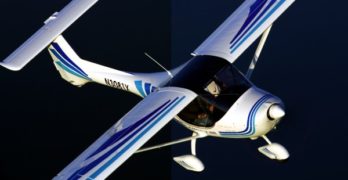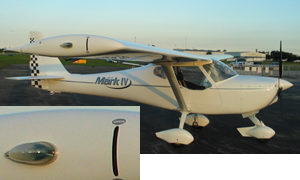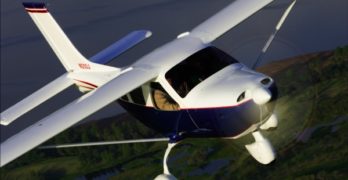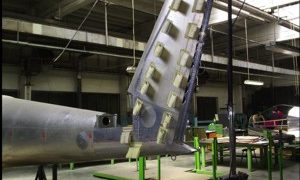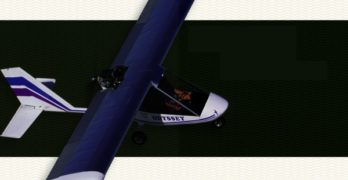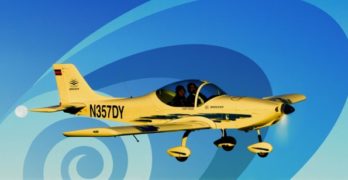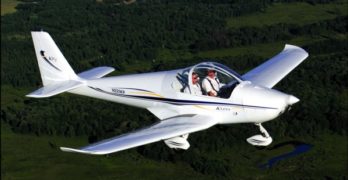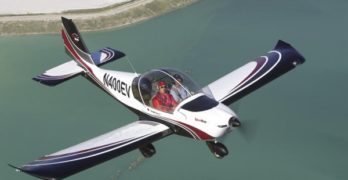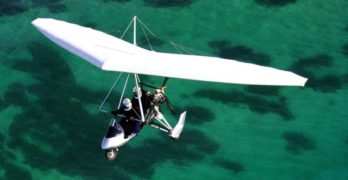The Allegro is the value leader among LSA designs.
One year ago, the fi rst special light-sport aircraft
(S-LSA) were approved and delivery of S-LSA began.
A few brands stand above the rest in the number of
aircraft delivered. One of those is the Allegro 2000, imported into
the United States from the Czech Republic by Fantasy Air USA. Since May 19, 2005,
when the Allegro earned S-LSA approval, Fantasy Air has delivered more than 40 aircraft,
keeping owners Doug and Betty Hempstead busy.
One of the appealing factors of the Allegro 2000 is its price, which starts in the upper
$50,000 range for the flyaway version. An airplane with an attractive price has a clear
advantage over others with higher price tags. When that airplane flies well, is supported
well, and has the equipment desired by consumers, it’s likely to succeed.
Well-Established
Given its fast start, Fantasy Air USA
has reason for optimism, but the
Allegro design has a much longer
history outside this country.
Search Results for : flight design ct
Not finding exactly what you expected? Try our advanced search option.
Select a manufacturer to go straight to all our content about that manufacturer.
Select an aircraft model to go straight to all our content about that model.
FK9 Now Imported with Folding, Shorter-Span Wings
The feature of folding wings is credited with the sale of many aircraft by brands such as Kitfox and Kolb (among numerous others). Promoting the Sport Pilot certificate, I’ve visited flight schools at busy airports where one of the obstacles to growth — and to adding a LSA as a trainer — has been a lack of more space to hangar their fleet. Now with FK Lightplanes USA bringing in their first two FK9 Mark IV B models, this could change. *** The Florida-based importer for the German design used in many of that country’s flight schools recently took delivery of its first two “B” versions configured as they will routinely import them. Their selection includes two-feet less span with the 100-hp Rotax 912S and folding wings as the standard model (though the 80-horse, non-folding wing models can be special ordered). The first customer, taking both aircraft, was the cooperative LetsFly.org that helps buyers share ownership of LSA and other aircraft.
Jabiru J250: A Great Cross Country LSA
What’s that airplane with the funny sounding name?
The question arises when pilots, unfamiliar with the new
brands introduced by the light-sport aircraft (LSA) category, try
to comprehend the name Jabiru.
“And this airplane company also makes its own engine?”
This second question frequently follows the first. Jabiru USA’s
Peter “Pete” Krotje and his staff must tire of the explanation.
“It’s JAB-i-roo,” I heard Pete reply patiently one day at EAA
AirVenture Oshkosh 2005. “And, yes, the company makes both
the airframe and engine.”
So begins the tale of this new airplane from the country down
under famous for kangaroos and cowboys who speak English
in a distinctly different way. Designed by Jabiru Australia of
Bundaberg West, Australia, the J250 and J170 recently earned
special light-sport aircraft (S-LSA) certification, which the
Calypso hopes to do soon as well.
It’s A Little Big Plane
As you walk up to the
J250, this modern, composite cruiser
looks like a small airplane, yet entering
the J250 is easy and, once inside, the
cockpit is surprisingly roomy, especially
given its enormous luggage area.
Ultralight Trainers for the Future
A more real concern about the
future of ultralights revolves around
the availability of ultralight trainers
to prepare new pilots for flight in
Part 103 ultralights like the Ultra.
Wonderful as many of the new LSA
may be, most are inappropriate aircraft
to train you for flight in a Hawk
Ultra|or almost any other genuine
103 machine. The question ponders
the likelihood of companies building
ultralight trainer-type aircraft as
fully built, fully certificated special
light-sport aircraft (S-LSA), the minimum
standard to which all trainers
must be built once the two-place
exemptions expire on January 31,
2008. (Note: Two-place trainers that
have transitioned to experimental
light-sport aircraft status, E-LSA, can
still be used for training purposes by
the original owner/instructor until
January 31, 2010.)
Even if ultralight manufacturers
do choose to build an S-LSA trainer,
will it be affordable? Again, consumer
demand will play a role in
this decision; CGS is evaluating the
market and may create an S-LSA
ultralight trainer.
A Glimpse at the S-LSA Certification Process
Tom Gunnarson
Recreational aircraft ownership can bring
great joy and satisfaction. From the pride of
knowing a plane is solely yours to outfitting it
to your personal tastes to the convenience of
flying it where and when you desire, private
ownership can bring many joys.
The new sport pilot and light-sport aircraft
(SP/LSA) regulations are reawakening interest
in basic flying in non-complex, two-seat aircraft
harkening to the golden age of aviation
when requirements for personal flight were
minimal. New-age materials, components,
and manufacturing processes, along with an
existing worldwide industry producing aircraft
to strict weight limits, have created a plethora
of ready-to-fly aerial deuce coupes just waiting
for the right regulatory environment to
burst on the American recreational aviation
scene. Not surprisingly then, the first aircraft
certificated in the special light-sport aircraft
(S-LSA) category were imports from Europe
where manufacturers have been building
these aircraft for 20 years.
The S-LSA certification process includes
many elements found in standard, productioncertificated
aircraft manufacturing.
Earthstar’s Odyssey Continues
After flying many ultralight and light-sport aircraft, I’ve found the handling
and performance characteristics of Earthstar Aircraft’s machines
suit me as well as or better than any others. With that said, let me
tell you about some significant changes that may thrust this small
California company into the mainstream of light-sport aviation.
Mark Beierle created the Thunder Gull series of ultralights after working in the
aerospace industry … and being discouraged with the ultralights available in the
early 1980s. He was interested in perfecting his designs, so his priority was not producing
numerous units. Instead, he wanted to produce an aircraft with classic flying
characteristics. Customer response to his machines was excellent, but delivery
often stretched into months, even years. To own a prized Earthstar model, you had
to have patience. This situation gave another company, Titan Aircraft, a chance to
build a similar design, the Titan Tornado, and its business took off while Earthstar
remained deliberately small.
Breezing Along
Like American
ultralights, European
microlights have paved the way
to a new breed of aircraft for European
fliers. Residents of the European community
don’t have the sport pilot/light-sport aircraft
(SP/LSA) rule, but they know how to build the planes
that serve the market.
Comco-Ikarus is one of Germany’s most
established microlight builders. After a
long and successful run with its C22
and C42 airplanes, the company,
based in Hohentengen in
southwest Germany, is
ready to run in LSA
circles with its
new Breezer.
Compared to the C22 and C42,
which is still being sold in Germany and
the United States, the Breezer is clearly
an original design. The Breezer has a
metal wing and tail, whereas the C42
has a fiberglass fuselage and its wings
are constructed of aluminum tubes and
covered with an advanced sewn textile
called GT-Foil, a Kevlar-based material.
The Breezer is a low-wing airplane,
whereas the C42 is a high-wing; the
C42 is strut-braced, while the Breezer
is cantilevered.
Kappa KP-5 An All metal Beauty
Kappa’s KP-5 … a great trainer and more!
At EAA AirVenture Oshkosh
2005, 13 aircraft on
display in the Light-Sport
Aircraft (LSA) Mall-
which put LSA on center
stage just south of AeroShell Square-
had their airworthiness certificates as
special light-sport aircraft (S-LSA). (A
14th aircraft, the Savage Cub, exhibited
in the North Commercial Area,
also earned its S-LSA certificate, but
only had one aircraft to display.) That
14 aircraft earned S-LSA certificates
in the short span of three and a half
months since the FAA announced
the availability of the final consensus
standards for LSA-category airplanes
is an unprecedented accomplishment.
No one can recall when so many airplanes
have been certificated in such
a short time.
One of those baker’s dozen plus
one is the Jihlavan (pronounced
“YEE-la-von”) KP-5, better known to
Americans by its importer’s name-
Kappa Aircraft KP-5. It is an elegantly
styled, all-metal LSA with a high-visibility
cockpit, a high-performance
wing with well-regarded Fowler
flaps, tough trailing link landing
gear, and the popular Rotax 912
powerplant.
A Sporty SportsStar: Leading the LSA Parade
Being first is often good in marketing, sports, or life in general, for that matter. In the light-sport aircraft (LSA) certification race, one aircraft has already won: the Czech Republic-built Evektor SportStar. This all-metal, low-wing, bubble-canopy design was the first aircraft to win its airworthiness certificate as a special LSA (S-LSA), and no one can ever take that distinction away.
Evektor Aerotechnik appointed Sport Aircraft International of Kerrville, Texas, as its American distributor. That company is currently in the process of transitioning to Evektor America as its new trade name. At EAA AirVenture Oshkosh 2005, it exhibited a beautifully finished SportStar SE alongside Evektor’s four-seat Cobra, which is aimed at the Cirrus market. In the LSA Mall, another SportStar presented itself to thousands of visitors.
I flew the first imported version of the SportStar, then called the EuroStar, a few years ago. The day after EAA AirVenture 2005 ended, I was delighted to join Evektor America President Jeff Conrad and rocket down Wittman Field’s runway in the newest SportStar SE (special edition).
AirBorne’s XT 912 Trike
Racing to be the first weight-shift S-LSA
In early January, the FAA accepted the ASTM consensus standards
for weight-shift control (WSC) aircraft, commonly known as trikes.
The agency’s action paved the way for trike manufacturers to certificate
ready-to-fly machines as special light-sport aircraft (S-LSA). Now,
the race is on to see which company will be the first to complete the
steps necessary to show compliance with the newly approved standards.
One company in the running is
AirBorne Australia, and it is already
accepting orders for its S-LSA model,
the AirBorne XT 912. How can it be so
confident this model will comply? Its
machines already meet Australia’s tough
certification standards, so the effort is
primarily one of paperwork. (Though
preparing documents to the FAA’s precise
requirements is no trivial task, as
anyone who has tried to correctly fill
out the sport pilot certificate application
knows.) Interestingly, Australia is
one of two nations-Colombia is the
other-that have accepted the sport
pilot/light-sport aircraft (SP/LSA) rule
as part of their national program.
- « Previous Page
- 1
- …
- 125
- 126
- 127
- 128
- 129
- …
- 145
- Next Page »


